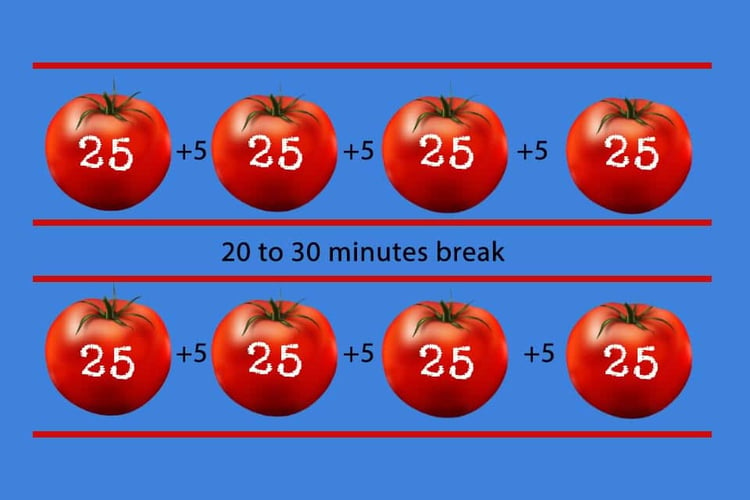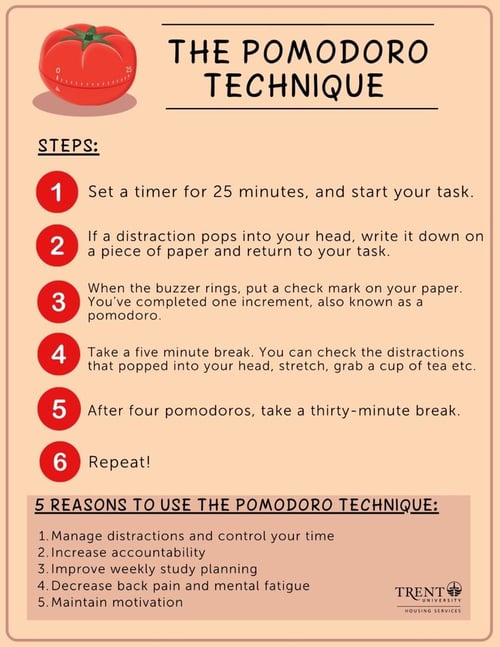Maintaining focus and motivation is one of the key struggles of any worker, no matter where and how you work. Email, phone notifications, Slack, and zillions of other distractions are tailor-made to tear us away from our work, making it sometimes seem impossible to concentrate and actually get the task at hand done.
What’s a modern worker to do?
Well, there are a thousand and one productivity techniques out there—which means that there’s likely one that will work for you. But who has time to try them all and evaluate them?
Thankfully, there’s one tried-and-tested technique with scientific backing for its effectiveness. And all it will cost you to try it is 30 minutes of your time.
What Is the Pomodoro Technique?
Developed by Berlin-based software engineer and consultant Francesco Cirillo while a university student in the 1980s (Cirillo, 2006), the Pomodoro Technique is remarkable for its simplicity and effectiveness.
You simply set a timer for 25 minutes, work intently on a single task for that entire time, and then take a 5-minute break before beginning another set.

The technique was named for the tomato-shaped kitchen timer (pomodoro in Italian) that Cirillo used to keep himself on task (Cirillo, 2006).
Why Does the Pomodoro Technique Work?
Simply put, doing Pomodoros keeps you focused and lets you do “deep work,” focusing on a single task instead of jumping around between various tasks and distractions, never quite accomplishing anything.
The human attention span is, frankly, rather short—we aren’t good at maintaining sustained focus for very long, especially on complex tasks (Szalma et al., 2004). There are a lot of factors which can affect this, and there’s always the chance that you’ll slip into that blissful state called “flow” where time seems to stop and you get a week’s worth of work done in an hour (Csikszentmihalyi et al., 1990).

But for the most part, even the most determined among us can only manage to be effective at a task for about 90 minutes at a time.
By aiming for 25-minute working periods followed by 5 minutes of rest, we’re better able to tune in to our brain’s natural ebb and flow, doing really great work for a short period of time, recharging, and then getting back to it (Feng, n.d.).
How Do I Use the Pomodoro Technique Right?
While the Pomodoro Technique is simple at its heart, there are a few ways to make sure you’re getting the most from it.
- Choose a specific task that you want to accomplish during your 25 minutes. Make sure that it’s either something you can complete in that time, or that has a natural break point at about the 25-minute mark so you can stop easily. For example, you might set the goal of editing three pages, if that works well with your natural pace.
- Do nothing complicated in your rest time. Your 5-minute break isn’t the time to check email, work on a blog post, or update your invoicing system. Research shows that both duration and type of task affect how well we sustain attention (Szalma et al., 2004) and simply switching to another cognitively demanding task for 5 minutes won’t give you the reset you need to focus well in your next pomo. Instead, try watching a funny cat video, doing a short meditation or getting your blood flowing with some jumping jacks or stair climbs.
- Interrupt your interruptions. During your pomo, set your phone to silent, close your email, turn off Slack notifications, and otherwise prepare to be undisturbed. The more you can narrow your attention, the more effective your 25-minute work bout will be (Cirillo, 2006).
- Create a flowing sequence. You might not get into full flow during a 25-minute working sprint, but you can create a flowing sequence for yourself. Plan out a few pomo tasks in a row, with each flowing logically into the next. If you’re editing a long paper, this will handle itself: you’ll just work for 25 minutes at a time on it. If you have other tasks to be handled, consider the sequence. Maybe you’ll start by answering emails, then choose the most important task from that batch to become its own pomo focus, and then move on to an
the assignment that’s due tomorrow in the third round once the immediate tasks have been accomplished.
- Give yourself a longer break. Every four pomodoros, take a longer break of 20-30 minutes. Have a snack. Take a walk. Play with the dog. Do something to recharge yourself before attempting another set.

By alternating between intensely focused, distraction-free work periods and short breaks, with a longer break after a series of these work sprints, you’ll soon find yourself getting a lot more accomplished—with a lot less stress!
You might even discover that you’re getting so much done with a few pomodoro sets that you can end your workday sooner and make that last resting period your entire evening. That’s a lot of benefit from a tiny tomato timer!
Here is a link for a pomodoro timer online - https://pomofocus.io/
References
Cirillo, F. (2006). The Pomodoro Technique (the pomodoro). Agile Processes in Software Engineering 54(2), 35.
Csikszentmihalyi, M., Abuhamdeh, S., & Nakamura, J. (1990). Flow.
Feng, J. (n.d.) An evaluation of the Pomodoro Technique for stopping procrastination and behaviour change.
Szalma, J. L., Warm, J. S., Matthews, G., Dember, W. N., Weiler, E. M., Meier, A., & Eggemeier, F. T. (2004). Effects of sensory modality and task duration on performance, workload, and stress in sustained attention. Human Factors, 46(2), 219-233.